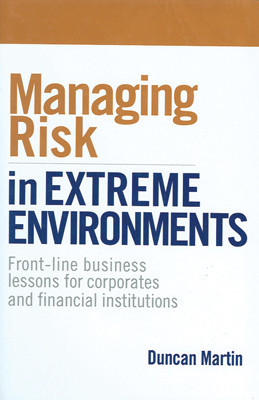Managing Risk in Extreme Environments: Front-line business lessons for corporates and financial institutions 01 Edition(English, Paperback, Duncan Martin)
Quick Overview
Product Price Comparison
High-profile disasters, from floods to terrorist attacks, appear in our newspapers and on our TV screens almost daily. However, the coverage rarely mentions risk or risk management. How do people and organizations really manage risk in such extreme circumstances? Youre an infectious disease consultant on an isolation ward in Toronto and your "atypical pneumonia" patient isnt responding to antibiotics... Youre off duty when the reactor melts down and you have to replace your boss who is in hospital with radiation poisoning... Youre the first emergency services personal on the platform after a bomb explodes on the London Underground and you have to decide who to save... When it really is a matter of life and death, how do risk management strategies stand up to the pressure? And do these radical situations have a practical relevance for risk management policies in todays business and financial worlds? Managing Risk in Extreme Environments looks at real-life examples and case studies from epidemics and terrorism to floods and earthquakes in order to extract risk management practices that have been tested in adverse conditions and shown to succeed. In drawing out such practices, Duncan Martin shows how these vital lessons can be transferred effectively to the less extreme operational environments in which most of us work. Managing Risk in Extreme Environments offers an informative and gripping account of how risk management works in extreme situations. The author presents nine case studies of risk management strategies and practices in extreme environments: novel epidemics, wildfires, terrorism, extreme humanitarian aid, mountain rescue, nuclear reactors, extractive industries, floods and earthquakes. These authoritative case studies provide a detailed assessment of the similarities and differences between these environments, and also a comparison with risk management in corporates and financial institutions. The author uses these powerful examples to identity seven "laws" of extreme risk management. In doing so, he illustrates the implications for risk management in general, and shows how such lessons can be applied effectively in less extreme operational environments within the business and banking sectors. About The Author Duncan Martin was educated at the University of Cambridge and the University of Pennsylvania (Wharton). He has worked in over a dozen countries and speaks five languages. He is presently Head of Wholesale Credit Risk Analytics at Royal Bank of Scotland in London. Prior to joining RBS, he was Director of Strategies Risk Management at Dresdner Kleinwort, and a senior consultant at both Oliver Wyman & Company and Booz Allen & Hamilton. Table of Contents Introduction Part 1 Case Studies Epidemic Outbreak An implicit risk appetite Threat level increasing Application to business Wildfire Natural fire loads Fire season planning Controlled burns Fighting fires Smokejumping Summary Application to business Terrorism Iraq The military Risk seeking Government response Intervention upstream Application to business Extreme humanitarian aid No accident Logistics MSF leaves Afghanistan Demining Application to business Mountain Avalanche Freedom to die No holiday allowance Application to business Meltdown Liquidation An impossibility As low as reasonably practicable Safety culture War Hubris and humility Application to business Extraction Gas fire Aceh Zero casualties Repair diving Legislation and safety culture Application to business Flood A 1 in 100 year storm? Flood protection Models in the community Limiting development in flood plains Rising waters Summary Application to business Earthquake Disaster in Bam Coordination problems Strong structures, rapid response Contingency planning and SEMS Summary Application to business Part II Themes Managing risk in extreme environments Think, plan, do Epidemic Wildfire Terrorism Extreme humanitarian aid Mountain Meltdown Extraction Flood Earthquake So what? Lessons for the risk management process From rethinking to replanning Models Contingency planning Specific lessons The seven laws of extreme risk management Death focuses the mind Honesty matters Reality beats simulation Standards drive success Beware unintended consequences Stuff happens Risk managers need a loud voice and a thick skin


